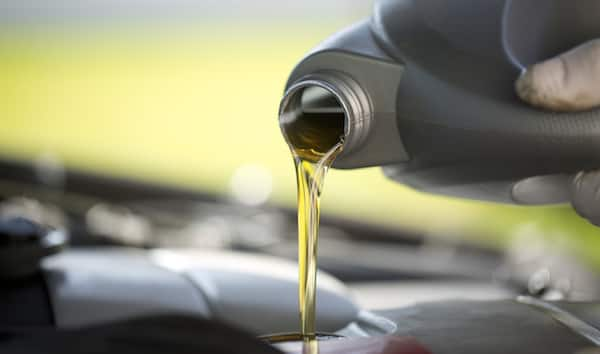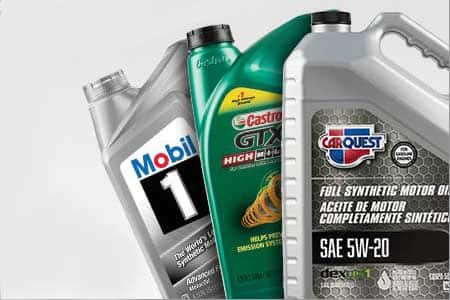
“220. 221. Whatever it takes.” That infamous line of reasoning worked for Jack Butler (Michael Keaton) in the 1983 movie Mr. Mom, so it should work for you, too, when it comes to selecting the right motor oil grade, right? Simply pick a number? Nope! Just like with electricity, when it comes to car oil, numbers matter—especially if you want to protect your engine.
Motor Oil Viscosity
Oil “weights” or grades—such as 10W-30—are actually a numerical coding system developed by the Society of Automotive Engineers (SAE) to grade oils based on their viscosity. Viscosity is measured by how long it takes a specific amount of oil to flow through a specific-sized opening at a specific temperature. The longer the oil takes to flow through, the higher the viscosity. The tool used to conduct that test is a "viscometer." To better visualize viscosity, think of pouring pancake syrup from the bottle. At warmer temperatures, the syrup pours fast and easy, while at colder temperatures, it’s thicker and more difficult to get flowing. The same can be said for engine oil. Only, the particular challenge with motor oil is that automotive engines need the opposite from their oil. When temperatures are freezing, engines need the oil to be thin and free flowing, not sluggish. But when temperatures rises, engines need the oil to stay thick as the engine reaches operating temperature. That’s where multi-weight or multi-grade oils enter the picture.
What does the "W" mean in oil grades?
SAE’s J300 standard, first published in 1911 and revised numerous times since, classifies oil into 11 viscosity grades—0W, 5W, 10W, 15W, 20W, 25W, 20, 30, 40, 50, and 60. The “W” signifies “winter,” not weight. Oils first received this “W” designation from SAE in the 1950s. The lower the number preceding the W, the lower the temperature for which the oil is rated. Those winter numbers were modified further after a rash of catastrophic engine failures in the early 1980s. Unusually cold weather in the U.S. and Europe caused oil to gel. When this occurred, the engine would still start, but it couldn’t pull the gelled oil out of the oil pan, resulting in the failures. As a result, SAE added a low-temperature test to measure pumping viscosity as well, and indicated this oil with the W specification.
The importance of temperature
Back to the idea of multi-weight oils. A popular oil, such as 10W-30, performs like two oils in one when it comes to engine lubrication. At colder temperatures it delivers a 10W-grade oil performance, while at higher temperatures it performs like a 30-grade oil. This provides engine protection at both ends of the temperature spectrum, which is important since engines have to operate in a range of temperatures. Think of it this way—that SAE 30 oil you might use in your riding mower has the same viscosity as the 10W-30 oil in your vehicle, but only at 210°, the maximum temperature that SAE requires. The difference arises at colder temperatures where the SAE 30 oil can’t perform, necessitating some enhancements that make it a multi-grade oil. At those lower temperatures, that’s where the 10W oil and its characteristics come into play. Oil’s desired performance characteristics at varied temperatures, as specified by SAE, are achieved through the addition of Viscosity Improvers (VI) or modifiers that increase the oil’s viscosity as temperatures rise. The result is oil that performs and provides engine lubrication no matter what the temperature.
Know what to look for
The good news is that you don’t need to be an engineer or chemist to know which car oil to use, and you don’t have to change your oil grade whenever the temperature changes. Simply follow the motor oil grade recommended by the vehicle manufacturer for optimal engine protection in all types of weather. Not sure where to find the oil grade for your vehicle? Usually you can find it printed on the oil cap, and occasionally it will be printed on a label under the hood. And of course you can always swing by your local Advance Auto Parts store when it's time for your next oil change, where an associate will be happy to help you.
It’s important to note that SAE also has a coding system for gear oil, such as the one that's used in a manual transmission, and that it’s different than the ratings for engine oil. So if there’s a bottle of 85W-140 oil sitting on the barn or garage shelf gathering dust, don’t put it in your engine. And finally, when choosing an oil, look for one with the American Petroleum Institute “donut” seal on the bottle. It indicates that the oil meets API performance standards. What kind of oil do you use in your engine? Leave us a comment.








